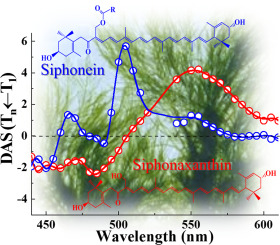Biochimica et Biophysica Acta (BBA) - Bioenergetics ( IF 4.3 ) Pub Date : 2020-03-11 , DOI: 10.1016/j.bbabio.2020.148186 Dan-Hong Li 1 , Wenda Wang 2 , Cuicui Zhou 2 , Yan Zhang 1 , Peng Wang 1 , Jian-Ren Shen 2 , Tingyun Kuang 2 , Jian-Ping Zhang 1

|
The light-harvesting complexes II (LHCIIs) of spinach and Bryopsis corticulans as a green alga are similar in structure, but differ in carotenoid (Car) and chlorophyll (Chl) compositions. Carbonyl Cars siphonein (Spn) and siphonaxanthin (Spx) bind to B. corticulans LHCII likely in the sites as a pair of lutein (Lut) molecules bind to spinach LHCII in the central domain. To understand the light-harvesting and photoprotective properties of the algal LHCII, we compared its excitation dynamics and relaxation to those of spinach LHCII been well documented. It was found that B. corticulans LHCII exhibited a substantially longer chlorophyll (Chl) fluorescence lifetime (4.9 ns vs 4.1 ns) and a 60% increase of the fluorescence quantum yield. Photoexcitation populated 3Car* equally between Spn and Spx in B. corticulans LHCII, whereas predominantly at Lut620 in spinach LHCII. These results prove the functional differences of the LHCIIs with different Car pairs and Chl a/b ratios: B. corticulans LHCII shows the enhanced blue-green light absorption, the alleviated quenching of 1Chl*, and the dual sites of quenching 3Chl*, which may facilitate its light-harvesting and photoprotection functions. Moreover, for both types of LHCIIs, the triplet excitation profiles revealed the involvement of extra 3Car* formation mechanisms besides the conventional Chl-to-Car triplet transfer, which are discussed in relation to the ultrafast processes of 1Chl* quenching. Our experimental findings will be helpful in deepening the understanding of the light harvesting and photoprotection functions of B. corticulans living in the intertidal zone with dramatically changing light condition.
中文翻译:

海洋绿藻Bryopsis corticulans主要触角的激发动力学和松弛。
作为绿色藻类的菠菜和Bryopsis corticulans的光捕获复合物II(LHCIIs)在结构上相似,但在类胡萝卜素(Car)和叶绿素(Chl)组成上有所不同。羰基汽车siphonein(Spn)和siphon黄嘌呤(Spx)可能在位点上与皮质芽孢杆菌LHCII结合,因为一对叶黄素(Lut)分子与中心域中的菠菜LHCII结合。为了了解藻类LHCII的光捕获和光保护特性,我们将其激发动力学和弛豫与菠菜LHCII的激发动力学和弛豫进行了比较,已有充分文献记载。发现皮质芽孢杆菌LHCII表现出显着更长的叶绿素(Chl)荧光寿命(4.9ns对4.1ns)和荧光量子产率增加60%。激发光3 Car *在皮质芽孢杆菌LHCII中的Spn和Spx之间相等,而在菠菜LHCII中主要在Lut620处。这些结果证明了该LHCIIs具有不同汽车对和叶绿素的功能差异一个/ b比率:B. corticulans LHCII示出了增强的蓝绿色的光吸收,的减轻淬火1叶绿素*,和淬火的双位点3叶绿素* ,这可能有助于其光收集和光保护功能。此外,对于两种类型的LHCII,三重态激发曲线均显示出额外的3个除了传统的Chl-Car三联体转移外,Car *形成机理也与1 Chl *淬灭的超快过程有关。我们的实验结果将有助于加深对生活在潮间带且光照条件急剧变化的皮质芽孢杆菌的光收集和光保护功能的理解。



























 京公网安备 11010802027423号
京公网安备 11010802027423号